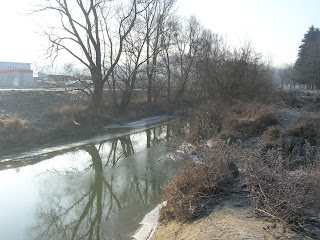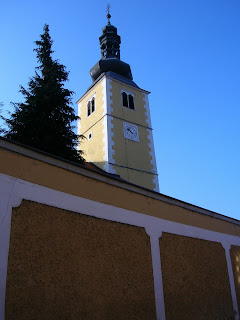
 Statue of the Holy Trinity on the Holy Trinity Square. (Ludbreg's Central square)
Statue of the Holy Trinity on the Holy Trinity Square. (Ludbreg's Central square) Holy Trinity Square. (Main square)
Holy Trinity Square. (Main square) Another view of the main square.
Another view of the main square.
There were always legends about Ludbreg being the "Center of the World." Erasmus Weddingen confirmed this belief when playing with a map and caliper. He drew several circles on a map using Ludbreg as a center. He noticed that on each of the circles lay one or more cities. A number of European capitals can be found equal distances away from Ludbreg. An example of this is that Budapest and Vienna are both 225 km away from Ludbreg.


 The first written traces of this church date back to 1334. The present day church was constructed in 1410. Since then it has been reconstructed several times. In the 18th century it received its baroque features.
The first written traces of this church date back to 1334. The present day church was constructed in 1410. Since then it has been reconstructed several times. In the 18th century it received its baroque features. 
I walked alongside this small river that connects to the Bednja river. Pretty little river. 










Since 1635 Ludbreg was in possession of the Erdödy family. In 1695 the powerful Batthyany clan took power over Ludbreg and held it until 1918. During that time, the castle got it's new appearance,walls surrounding the fortress and the tower were torn down, and the castle got it's third floor. In 1939 the castle was bought off by Municipality of Ludbreg.
In 1411 a priest was celebrating Mass in the Chapel of Count Batthyanys Castle. During the consecration of the wine the priest doubted the truth of transubstantiation and the wine in the chalice turned into blood. The priest didn't know what to do so he embedded the relic in the wall behind the main alter. The priest and workman kept this a secret. It was only reveled at the time of the priests death. After the priests revelation, news of the relic quickly spread and people started coming on pilgrimage to Ludbreg. This miracle relic was then brought to Rome. In the 1500's a commission was convened in Ludbreg to investigate the facts connected with the Eucharistic miracle. On April 14, 1513, Pope Leo X published a Bull permitting veneration of the holy relic. The relic has since been returned to Croatia.



The Croatian region of Moslavina was ravaged by plague during the 18th Century. The Croatian parliament in Varaždin vowed that if God stopped the epidemic "a church of Christ 's Tomb of Jerusalem would be risen at the place where the greatest treasure of Croatian Kingdom was stored, in Ludbreg." The vow wasn't fulfilled until 1994 when democracy was restored in Croatia. This church was what was constructed.
The grounds surrounding the sanctuary dedicated to the Trinity.

In 2005 artist Marijan Jakubin painted this fresco in the church. In place of the Apostles Croatian saints and blesseds were painted. 
After a half day of exploring we had a small lunch at a local resturant then headed home.


















No comments:
Post a Comment